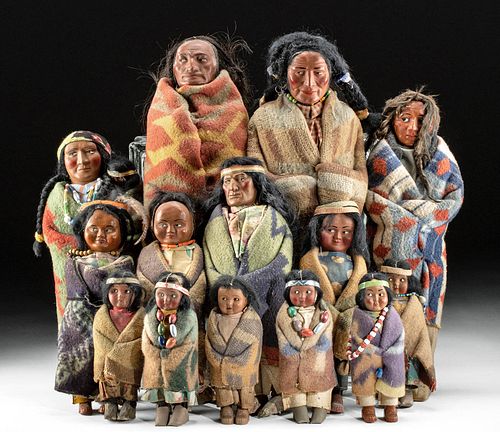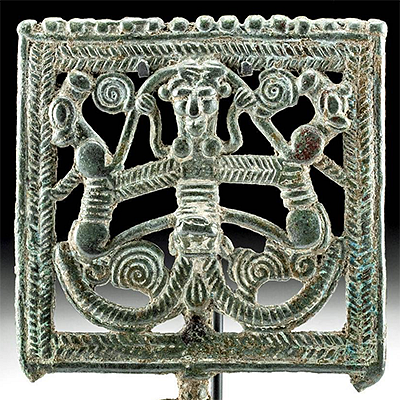14 Vintage Native American Dolls - 5 Skookum
Lot 90
About Seller
Artemis Fine Arts
686 S Taylor Ave, Ste 106
Louisville, CO 80027
United States
Selling antiquities, ancient and ethnographic art online since 1993, Artemis Gallery specializes in Classical Antiquities (Egyptian, Greek, Roman, Near Eastern), Asian, Pre-Columbian, African / Tribal / Oceanographic art. Our extensive inventory includes pottery, stone, metal, wood, glass and textil...Read more
Categories
Estimate:
$1,600 - $2,400
Absentee vs Live bid
Two ways to bid:
- Leave a max absentee bid and the platform will bid on your behalf up to your maximum bid during the live auction.
- Bid live during the auction and your bids will be submitted real-time to the auctioneer.
Bid Increments
| Price | Bid Increment |
|---|---|
| $0 | $25 |
| $300 | $50 |
| $1,000 | $100 |
| $2,000 | $250 |
| $5,000 | $500 |
| $10,000 | $1,000 |
| $20,000 | $2,500 |
| $50,000 | $5,000 |
| $100,000 | $10,000 |
| $200,000 | $20,000 |
About Auction
By Artemis Fine Arts
Nov 5, 2020
Set Reminder
2020-11-05 10:00:00
2020-11-05 10:00:00
America/New_York
Bidsquare
Bidsquare : Ancient & Ethnographic From Around the World
https://www.bidsquare.com/auctions/artemis-gallery/ancient-ethnographic-from-around-the-world-5916
Ancient art from Egypt, Greece, Italy and the Near East, as well as Asian, Pre-Columbian, Native American, African / Tribal / Oceanic, Spanish Colonial, Russian Icons, Fine art, much more! All categories, all price ranges... all legally acquired and guaranteed to be as described or your money back. Artemis Fine Arts info@artemisfinearts.com
Ancient art from Egypt, Greece, Italy and the Near East, as well as Asian, Pre-Columbian, Native American, African / Tribal / Oceanic, Spanish Colonial, Russian Icons, Fine art, much more! All categories, all price ranges... all legally acquired and guaranteed to be as described or your money back. Artemis Fine Arts info@artemisfinearts.com
- Lot Description
New World, America, California, 1920 to 1969. An intriguing set of 14 male and female Native American "Skookum" dolls, all standing and wrapped in polychrome blankets of geometric designs. All of these fascinating figurines feature round faces with slender eyes looking out to their right, slim eyebrows, flat noses, thin lips, and high cheekbones framed by long black hair and are dressed in linen and felt dresses, shirts, and pants of varying colors and patterns and tan moccasins. Many are additionally adorned with rosy cheeks, cloth or paper headbands, beaded necklaces, and braided hair. A few exhibit additional ornaments, such as a feathered headdress, a bandana, or a baby. Although 5 include a Skookum marking on their foot, all are clearly influenced by the Skookum doll aesthetic. The composite medium of the dolls can help to date them; while the earlier dolls are mostly made of wood with dowel rod legs, bodies stuffed with twigs, leaves, straw, and grass, and feet wrapped in suede, leather, or paper, the dolls made after 1948 are almost entirely plastic. Size of Largest: 5.25" L x 3.5" W x 17" H (13.3 cm x 8.9 cm x 43.2 cm)
Mary McAboy (1876 to 1961) started making Native American dolls wrapped in blankets with apple heads in 1913, following the tradition of her mother who frequently made apple head dolls to give to friends and sell at social events. Astounded by their popularity, she soon obtained a patent for their design and the name "Skookum", a slang term from the United States Pacific Northwest meaning excellent or mighty. In 1920, Mary joined forces with the H.H. Tammen Company and began mass production and nationwide distribution of her Skookum dolls, which gradually changed from apple head dolls to dolls completely made from plastic composite, and continued to oversee production until her death in 1961. An excellent representation of her work, these dolls are just a small example of her business empire.
Another example of a Skookum doll can be found at Hood Museum of Art at Dartmouth College under the accession number 987.35.26724.
Provenance: private Orange County, California, USA collection
All items legal to buy/sell under U.S. Statute covering cultural patrimony Code 2600, CHAPTER 14, and are guaranteed to be as described or your money back.
A Certificate of Authenticity will accompany all winning bids.
We ship worldwide and handle all shipping in-house for your convenience.
#157427Excellent with some miniscule fraying and apertures of fabric and chipping to paint as commensurate with age. Remarkable remaining pigment.Condition
- Shipping Info
-
All shipping is handled in-house for your convenience. Your invoice from Artemis Gallery will include shipping calculation instructions. If in doubt, please inquire BEFORE bidding for estimated shipping costs for individual items.
-
- Buyer's Premium



 EUR
EUR CAD
CAD AUD
AUD GBP
GBP MXN
MXN HKD
HKD CNY
CNY MYR
MYR SEK
SEK SGD
SGD CHF
CHF THB
THB


















